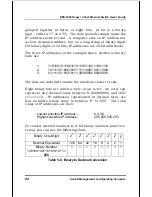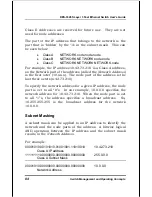
DES-3326S Layer 3 Fast Ethernet Switch User’s Guide
96
Switch Management and Operating Concepts
TCP/IP is a layered set of protocols. An example, such as
sending e-mail, can illustrate this. There is first a protocol for
sending and receiving e-mail. This protocol defines a set of
commands to identify the sender, the recipient, and the content
of the e-mail. The e-mail protocol will not handle the actual
communication between the two computers, this is done by
TCP/IP. TCP/IP handles the actual sending and receiving of
the packets that make up the e-mail exchange.
TCP makes sure the e-mail commands and messages are
received by the appropriate computers. It keeps track of what
is sent and what is received, and retransmits any packets that
are lost or dropped. TCP also handles the division of large
messages into several Ethernet packets, and makes sure these
packets are received and reassembled in the correct order.
Because these functions are required by a large number of
applications, they are grouped into a single protocol, rather
than being the part of the specifications for just sending e-mail.
TCP is then a library of routines that application software can
use when reliable network communications are required.
IP is also a library of routines, but with a more general set of
functions. IP handles the routing of packets from the source to
the destination. This may require the packets to traverse many
different networks. IP can route packets through the necessary
gateways and provides the functions required for any user on
one network to communicate with any user on another
connected network.
The communication interface between TCP and IP is relatively
simple. When IP received a packet, it does not know how this
packet is related to others it has sent (or received) or even
which connection the packet is part of. IP only knows the
address of the source and the destination of the packet, and it
makes its best effort to deliver the packet to its destination.
Содержание DES-3326S - Switch - Stackable
Страница 12: ...xii Identifying a Data Loop 335 Avoiding Trouble 335 Brief Review of Bitwise Logical Operations 342 Index 344...
Страница 188: ...DES 3326S Layer 3 Fast Ethernet Switch User s Guide 188 Web Based Switch Management Figure 6 11 Basic Switch Setup...
Страница 236: ...DES 3326S Layer 3 Fast Ethernet Switch User s Guide 236 Web Based Switch Management Count in the RIP routing protocol...
Страница 272: ...DES 3326S Layer 3 Fast Ethernet Switch User s Guide 272 Web Based Switch Management Figure 6 73 STP Port Settings...
Страница 297: ...DES 3326S Layer 3 Fast Ethernet Switch User s Guide Web Based Switch Management 297...
Страница 298: ...DES 3326S Layer 3 Fast Ethernet Switch User s Guide 298 Web Based Switch Management Figure 6 91 IP Address Table...
Страница 302: ...DES 3326S Layer 3 Fast Ethernet Switch User s Guide 302 Web Based Switch Management Figure 6 93 ARP Table...
Страница 315: ...DES 3326S Layer 3 Fast Ethernet Switch User s Guide Web Based Switch Management 315 Figure 6 104 Switch History...
Страница 321: ...DES 3326S Layer 3 Fast Ethernet Switch User s Guide Understanding and Troubleshooting the Spanning Tree Protocol 321...
Страница 323: ...DES 3326S Layer 3 Fast Ethernet Switch User s Guide Understanding and Troubleshooting the Spanning Tree Protocol 323...
Страница 325: ...DES 3326S Layer 3 Fast Ethernet Switch User s Guide Understanding and Troubleshooting the Spanning Tree Protocol 325...
Страница 327: ...DES 3326S Layer 3 Fast Ethernet Switch User s Guide Understanding and Troubleshooting the Spanning Tree Protocol 327...
Страница 329: ...DES 3326S Layer 3 Fast Ethernet Switch User s Guide Understanding and Troubleshooting the Spanning Tree Protocol 329...
Страница 341: ...DES 3326S Layer 3 Fast Ethernet Switch User s Guide Understanding and Troubleshooting the Spanning Tree Protocol 341...
Страница 349: ......
















































